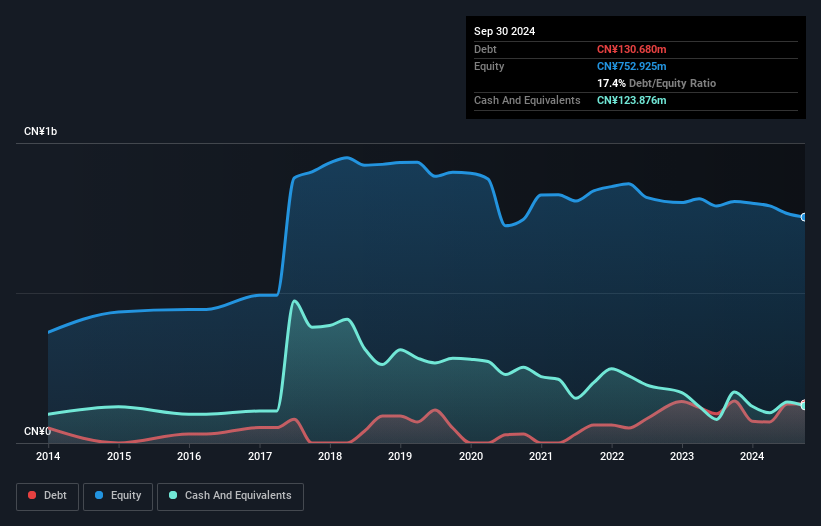Ribo Fashion Group (SHSE:603196) Is Making Moderate Use Of Debt

Warren Buffett famously said, 'Volatility is far from synonymous with risk.' It's only natural to consider a company's balance sheet when you examine how risky it is, since debt is often involved when a business collapses. As with many other companies Ribo Fashion Group Co., Ltd. (SHSE:603196) makes use of debt. But is this debt a concern to shareholders?
When Is Debt A Problem?
Debt is a tool to help businesses grow, but if a business is incapable of paying off its lenders, then it exists at their mercy. If things get really bad, the lenders can take control of the business. However, a more usual (but still expensive) situation is where a company must dilute shareholders at a cheap share price simply to get debt under control. Of course, plenty of companies use debt to fund growth, without any negative consequences. When we examine debt levels, we first consider both cash and debt levels, together.
Check out our latest analysis for Ribo Fashion Group
What Is Ribo Fashion Group's Debt?
As you can see below, Ribo Fashion Group had CN¥130.7m of debt at September 2024, down from CN¥140.1m a year prior. However, it also had CN¥123.9m in cash, and so its net debt is CN¥6.80m.

A Look At Ribo Fashion Group's Liabilities
According to the last reported balance sheet, Ribo Fashion Group had liabilities of CN¥363.3m due within 12 months, and liabilities of CN¥35.6m due beyond 12 months. On the other hand, it had cash of CN¥123.9m and CN¥101.6m worth of receivables due within a year. So its liabilities outweigh the sum of its cash and (near-term) receivables by CN¥173.4m.
Since publicly traded Ribo Fashion Group shares are worth a total of CN¥3.92b, it seems unlikely that this level of liabilities would be a major threat. However, we do think it is worth keeping an eye on its balance sheet strength, as it may change over time. Carrying virtually no net debt, Ribo Fashion Group has a very light debt load indeed. When analysing debt levels, the balance sheet is the obvious place to start. But it is Ribo Fashion Group's earnings that will influence how the balance sheet holds up in the future. So if you're keen to discover more about its earnings, it might be worth checking out this graph of its long term earnings trend.
Over 12 months, Ribo Fashion Group saw its revenue hold pretty steady, and it did not report positive earnings before interest and tax. While that hardly impresses, its not too bad either.
Caveat Emptor
Over the last twelve months Ribo Fashion Group produced an earnings before interest and tax (EBIT) loss. Indeed, it lost CN¥43m at the EBIT level. Considering that alongside the liabilities mentioned above does not give us much confidence that company should be using so much debt. Quite frankly we think the balance sheet is far from match-fit, although it could be improved with time. We would feel better if it turned its trailing twelve month loss of CN¥44m into a profit. So to be blunt we do think it is risky. The balance sheet is clearly the area to focus on when you are analysing debt. However, not all investment risk resides within the balance sheet - far from it. For example - Ribo Fashion Group has 1 warning sign we think you should be aware of.
If you're interested in investing in businesses that can grow profits without the burden of debt, then check out this free list of growing businesses that have net cash on the balance sheet.
New: AI Stock Screener & Alerts
Our new AI Stock Screener scans the market every day to uncover opportunities.
• Dividend Powerhouses (3%+ Yield)
• Undervalued Small Caps with Insider Buying
• High growth Tech and AI Companies
Or build your own from over 50 metrics.
Have feedback on this article? Concerned about the content? Get in touch with us directly. Alternatively, email editorial-team (at) simplywallst.com.
This article by Simply Wall St is general in nature. We provide commentary based on historical data and analyst forecasts only using an unbiased methodology and our articles are not intended to be financial advice. It does not constitute a recommendation to buy or sell any stock, and does not take account of your objectives, or your financial situation. We aim to bring you long-term focused analysis driven by fundamental data. Note that our analysis may not factor in the latest price-sensitive company announcements or qualitative material. Simply Wall St has no position in any stocks mentioned.
About SHSE:603196
Ribo Fashion Group
Engages in design, production, and sale of clothing products for women in China.
Adequate balance sheet minimal.
Market Insights
Community Narratives



